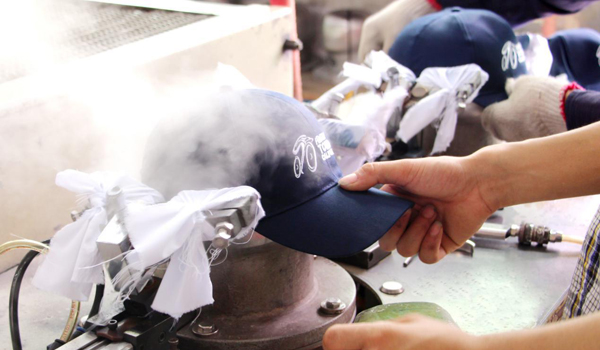Venturing into the hat business can be both an exciting and lucrative endeavor. However, understanding the financial commitment involved is crucial for aspiring entrepreneurs. In this comprehensive guide, we delve into the intricacies of hat production costs, equipment expenses, and other fundamental factors that determine the startup expenses of a hat business.

Image: www.cap-factory.com
Hat Production Costs: A Breakdown
The primary cost associated with starting a hat business lies in hat production. This involves the materials, labor, and manufacturing processes required to bring your designs to life. The type of hats you intend to make significantly influences these costs.
Fabric and Materials: Your Canvas
The cornerstone of any hat lies in its fabric and materials. From breathable cotton to luxurious wool and waterproof nylon, the choice of materials dictates both the cost and the characteristics of your hats. For instance, high-quality fabrics and premium trims elevate the product’s value but escalate the manufacturing expenses.
Labor: The Art of Hat Making
Craftmanship plays a pivotal role in hat production. Skilled artisans employ specialized techniques to shape and sew the materials, ensuring durability, comfort, and aesthetic appeal. Labor costs vary depending on the complexity of the designs, production volume, and location of manufacturing.
 Image: www.stxaviersschooljaipur.com
Image: www.stxaviersschooljaipur.comManufacturing Processes: Bringing Designs to Life
The transformation of raw materials into finished hats entails a series of manufacturing processes. These can range from basic sewing and cutting to specialized techniques like embroidery, printing, and molding. Each process incurs its own cost, contributing to the overall production expenses.
Equipment Investment: Your Production Arsenal
Establishing a hat production facility necessitates an investment in essential equipment. The types and quantity of machinery depend on the scale and scope of your business operations. Nevertheless, aspiring hat makers should prepare for the following:
Sewing Machines: The Heart of Production
The backbone of hat production lies in reliable sewing machines. Specialized machines designed for working with different fabrics and materials are often required, impacting the equipment budget.
Cutting Machines: Precision in Every Cut
Precision cutting is essential for achieving uniform and high-quality hats. Investing in electric or manual cutting machines ensures accuracy and streamlines production.
Finishing Equipment: The Final Touches
Once hats are sewn and cut, they undergo finishing processes to enhance their aesthetic appeal and durability. This may include equipment for steaming, pressing, and embellishing.
Additional Startup Costs: Beyond Production
Apart from production-related expenses, aspiring hat entrepreneurs must consider additional costs critical to business operations:
Design and Development: Creating Unique Styles
Distinctive hat designs set your brand apart. Professional designers can transform your ideas into marketable prototypes, but their services come at a cost that varies based on experience and the complexity of the designs.
Packaging and Branding: Protecting Your Product
Hats need to be protected and presented in a manner that reflects your brand’s identity. Custom packaging and branding materials, such as labels and tags, contribute to the overall product experience and incur additional expenses.
Marketing and Sales: Reaching Your Audience
Effective marketing and sales strategies are essential for reaching your target audience. This may involve online advertising, social media campaigns, or collaborations with retailers, all of which come with varying costs.
Overhead Expenses: The Day-to-Day Costs
Running a business involves recurring overhead expenses such as rent, utilities, insurance, and administrative costs. These ongoing expenses must be factored into the financial planning for a sustainable hat business.
Calculating Your Startup Budget
Determining the startup budget for a hat business requires a thorough assessment of the aforementioned costs. Based on the type of hats you intend to produce, the scale of your operations, and your location, you can estimate the following expense categories:
Production Costs:
- Fabric and materials
- Labor
- Manufacturing processes
Equipment Investment:
- Sewing machines
- Cutting machines
- Finishing equipment
Additional Startup Costs:
- Design and development
- Packaging and branding
- Marketing and sales
- Overhead expenses
By carefully estimating each category, you can arrive at a comprehensive startup budget that provides a solid foundation for your hat business.
Strategies for Optimizing Costs
Aspiring hat makers can implement various strategies to optimize startup costs and ensure profitability:
Negotiating Material Prices: Cost-Effective Sourcing
Establish relationships with reliable suppliers and negotiate bulk discounts for materials. Exploring alternative materials and exploring cost-effective sourcing options can significantly reduce production costs.
Utilizing Freelance Services: Flexibility and Savings
Consider outsourcing design, marketing, and administrative tasks to freelancers or agencies. This allows you to tap into specialized expertise while reducing fixed labor costs.
Leveraging Technology: Automation and Efficiency
Incorporate technology into your production processes to enhance efficiency and save on labor expenses. Automated sewing machines and computerized cutting systems can accelerate manufacturing, reducing overall costs.
Minimizing Overhead Expenses: Prudent Spending
Seek cost-effective options for rent, utilities, and other overhead expenses. Consider shared workspaces or negotiating favorable lease terms to minimize these ongoing costs.
Embracing Sustainability: Eco-Friendly and Cost-Saving
Incorporating sustainable practices into your hat business can not only reduce environmental impact but also lead to cost savings. Using recycled materials, implementing energy-efficient processes, and minimizing waste can contribute to both environmental and financial sustainability.
How Much Does It Cost To Start A Hat Business
Conclusion
Starting a hat business requires careful planning and a sound understanding of the associated costs. By considering production expenses, equipment investment, and additional startup costs, aspiring hat makers can create a comprehensive budget that sets the foundation for a successful business. Strategic sourcing, leveraging technology, and embracing cost-optimizing strategies can help entrepreneurs navigate the financial challenges and establish a profitable hat business. Whether you envision crafting artisanal masterpieces or producing trendy and affordable headwear, the journey ahead holds both excitement and the potential for financial rewards.